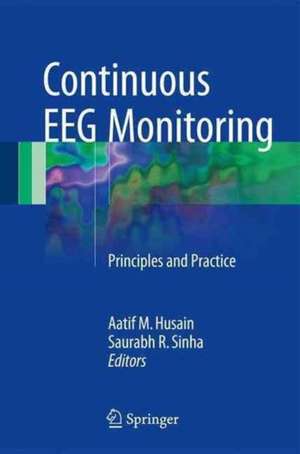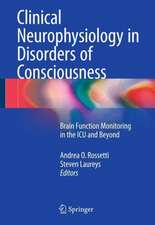Continuous EEG Monitoring: Principles and Practice
Editat de Aatif M. Husain, Saurabh R. Sinhaen Limba Engleză Hardback – 12 ian 2017
This book is designed to meet the need for a practically oriented textbook on the rapidly growing field of continuous EEG (cEEG) monitoring. A wide range of key clinical aspects are addressed, with explanation of status epilepticus classification, criteria for institution of monitoring, seizure patterns and their recognition, quantitative EEG analysis, and neuroimaging in patients undergoing cEEG monitoring. The value of cEEG and the nature of cEEG findings in various special situations are then reviewed, covering particular pathologies, critical care considerations, and prognostication. Treatments of nonconvulsive status epilepticus (NCSE) and nonconvulsive seizures (NCS) are discussed. The concluding section is devoted to important administrative issues including billing, staffing issues, comparison of EEG machines, and information technology (IT) issues.
Continuous EEG monitoring offers the only reliable means of detecting seizures that are not clinically obvious in critically ill patients. Such seizures are common: approximately 20% of patients undergoing cEEG monitoring in hospital have NCSE or NCS. Against this background, many hospitals have started to offer cEEG monitoring as a basis for delivery of appropriate treatment. By presenting the state of the art in cEEG monitoring, this book will be invaluable to practitioners including neurophysiologists, neurologists, neurointensivists, intensivists, neurophysiology and epilepsy fellows, and neurology residents.
Preț: 1954.04 lei
Preț vechi: 2056.89 lei
-5% Nou
Puncte Express: 2931
Preț estimativ în valută:
373.92€ • 399.83$ • 311.76£
373.92€ • 399.83$ • 311.76£
Carte tipărită la comandă
Livrare economică 14-19 aprilie
Preluare comenzi: 021 569.72.76
Specificații
ISBN-13: 9783319312286
ISBN-10: 3319312286
Pagini: 619
Ilustrații: XV, 671 p. 283 illus., 206 illus. in color.
Dimensiuni: 155 x 235 x 34 mm
Greutate: 13.97 kg
Ediția:1st ed. 2017
Editura: Springer International Publishing
Colecția Springer
Locul publicării:Cham, Switzerland
ISBN-10: 3319312286
Pagini: 619
Ilustrații: XV, 671 p. 283 illus., 206 illus. in color.
Dimensiuni: 155 x 235 x 34 mm
Greutate: 13.97 kg
Ediția:1st ed. 2017
Editura: Springer International Publishing
Colecția Springer
Locul publicării:Cham, Switzerland
Cuprins
Part 1 Clinical Aspects: History of CEEG Monitoring.- Neurologic injury with recurrent electrographic seizures.- Epidemiology of Seizures in ICU.- Epidemiology of Seizures in ICU in Pediatrics.- SE/NCSE/NSC Classification.- Criteria for cEEEG Monitoring.- Electrographic seizures – Recognition.- Electrographic seizures – Samples.- Periodic complexes – Classification.- Periodic complexes – Examples.- Patterns of uncertain significance.- Seizure Patterns in Pediatrics – Recognition.- Seizure Patterns in Pediatrics – Examples.- Artifacts Resembling Seizures and Periodic Complex.- Quantitative EEG Analysis – Basics.- QEEG in Seizure Detection.- QEEG Samples – Seizures.- QEEG in Neonatal Seizures.- QEEG in Nonseizure Indications.- QEEG Training Module.- Neuroimaging.- Part 2 Special Situations: Acute anoxic encephalopathy.- Autoimmune and Infectious NCSE/NCS.- Focal Neurologic Injury and NCSE/NCS.- Non-Neurologic Causes of NCSE/NCS.- Therapeutic Hypothermia in Children.- Medication Induced NCSE/NCS.- Super refractory SE.- Critical Care Considerations.- Prognostication.- Prognostication in Pediatrics.- Part 3 Treatment: Treatment of NCSE/NCS with Nonsedating AEDs.- Treatment of NCSE/NCS with General Anesthetics.- Other Treatment Options for NCSE/NCS.- Treatment of NCSE/NCS in Pediatrics.- Investigational Treatments for NCSE/NCS.- Part 4 Administrative Issues: EEG Equipment.- Electrodes and Montages.- Technical Considerations.- Staffing Issues.- Training Requirements.- Billing Considerations.- Reporting Results.- IT Issues.
Recenzii
“It not only has comprehensive details for the epileptologists but also has information on scientific investigations, technical details, and staffing models/descriptions of current practice which will be useful for a broader audience. … I would recommend this book as a good reference tool, a summary of the literature on cEEG, and a valuable resource for anyone who reads ICU EEG and who does inpatient epilepsy consults and for practicing neurointensivist.” (Stephen Hantus, Journal of Clinical Neurophysiology, May 29, 2019)
Notă biografică
Prof. Aatif Husain, Duke University Medical Center, Neurology, 330 Trent Drive, Durham, NC 27710, USA
Dr. Saurabh R. Sinha, Duke University Medical Center, Neurology, 330 Trent Drive, Durham, NC 27710, USA
Textul de pe ultima copertă
This book is designed to meet the need for a practically oriented textbook on the rapidly growing field of continuous EEG (cEEG) monitoring. A wide range of key clinical aspects are addressed, with explanation of status epilepticus classification, criteria for institution of monitoring, seizure patterns and their recognition, quantitative EEG analysis, and neuroimaging in patients undergoing cEEG monitoring. The value of cEEG and the nature of cEEG findings in various special situations are then reviewed, covering particular pathologies, critical care considerations, and prognostication. Treatments of nonconvulsive status epilepticus (NCSE) and nonconvulsive seizures (NCS) are discussed. The concluding section is devoted to important administrative issues including billing, staffing issues, comparison of EEG machines, and information technology (IT) issues.
Continuous EEG monitoring offers the only reliable means of detecting seizures that are not clinically obvious in critically ill patients. Such seizures are common: approximately 20% of patients undergoing cEEG monitoring in hospital have NCSE or NCS. Against this background, many hospitals have started to offer cEEG monitoring as a basis for delivery of appropriate treatment. By presenting the state of the art in cEEG monitoring, this book will be invaluable to practitioners including neurophysiologists, neurologists, neurointensivists, intensivists, neurophysiology and epilepsy fellows, and neurology residents.
Caracteristici
Explains the use and interpretation of continuous EEG (cEEG) monitoring in critically ill patients Examines the value of cEEG monitoring in various special situations Covers practical topics such as billing, staffing issues, comparison of EEG machines, and training requirements for technologists and physicians












